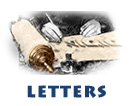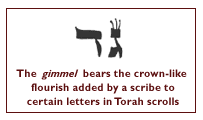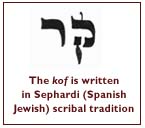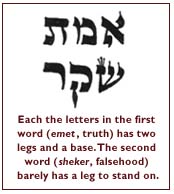


There are
those who think that the Hebrew alphabet is a branch of linguistics, while
others consider it an offshoot of mathematics with mystical implications.
The latter contend
that we must somehow account for the fact that each of the twenty-two letters
of the Hebrew alphabet has a numerical value – from 1 to 400. Based on
this fact, a system of calculating the numerical value of Hebrew words and
searching for other words or phrases of equal value was developed; according
to this methodology, known as "gematria" (numerology), two
words whose letters have equivalent numerical values are not only related
but have hidden meanings or oracular powers – even if they have no etymolygical
connection. How do we know for example that two people in love make up a new,
mystical unity? Just look at the numerical value of love, (ahavah), 1+5+2+5=13, which is the same as that of one,
(ahavah), 1+5+2+5=13, which is the same as that of one, (ehad),
1+8+4=13.
(ehad),
1+8+4=13.
( Learn more about gematria).
 Linguists
too, when dealing with Hebrew letters, often wax mathematical. Avraham
Even-Shoshan, in his Concordance to the Bible, takes pains to point
out, for example, that the letter
Linguists
too, when dealing with Hebrew letters, often wax mathematical. Avraham
Even-Shoshan, in his Concordance to the Bible, takes pains to point
out, for example, that the letter  (alef) appears in the Tanakh (Bible) exactly 27,057 times.
(alef) appears in the Tanakh (Bible) exactly 27,057 times.
 Even-Shoshan
points out that, in 19 words, the Torah records an alef where
none is appropriate and that, in 26 words, an alef that should
be present is missing. He also indicates that there is one letter alef
in the Tanakh that is smaller than all the rest and one alef
that is bigger. Surely there is meaning, however shrouded in mystery,
in these phenomena.
Even-Shoshan
points out that, in 19 words, the Torah records an alef where
none is appropriate and that, in 26 words, an alef that should
be present is missing. He also indicates that there is one letter alef
in the Tanakh that is smaller than all the rest and one alef
that is bigger. Surely there is meaning, however shrouded in mystery,
in these phenomena.
Today,
small letters are called  (otiot shel tal u-matar), letters for dew and rain, because the
Prayer for Rain (known in Hebrew as Tefillat Tal u-matar) in
the prayerbook is indicated by small letters. On the other hand, letters
appearing in any book in large print are referred to in Hebrew as
(otiot shel tal u-matar), letters for dew and rain, because the
Prayer for Rain (known in Hebrew as Tefillat Tal u-matar) in
the prayerbook is indicated by small letters. On the other hand, letters
appearing in any book in large print are referred to in Hebrew as  (otiot shel kiddush levanah), letters for sanctifying the new
moon. This is because the blessing for the Sanctification of the Moon
is recited outdoors by moonlight, and the print in the prayerbook is
therefore always large.
(otiot shel kiddush levanah), letters for sanctifying the new
moon. This is because the blessing for the Sanctification of the Moon
is recited outdoors by moonlight, and the print in the prayerbook is
therefore always large.
However
succulent these numerical tidbits may be, it is as vocabulary items
that Hebrew letters are truly fascinating. The English word "alphabet"
comes (by way of Greece) from the first two Hebrew letters, and 
 (alef, bet) and the word "camel" comes from the third
letter
(alef, bet) and the word "camel" comes from the third
letter  (gimel), because that's what the letter supposedly looked like.
Continuing into the letter
(gimel), because that's what the letter supposedly looked like.
Continuing into the letter  (dalet), the Hebrew word for "to alphabetize" is
(dalet), the Hebrew word for "to alphabetize" is  (le-avged), after the first four letters of the Hebrew alphabet.
(le-avged), after the first four letters of the Hebrew alphabet.
The
Hebrew word for letter itself is,  (ot), a word with a myriad of fascinating connotations and usages.
Firstly, the noun (ot), letter, gives us the verb
(ot), a word with a myriad of fascinating connotations and usages.
Firstly, the noun (ot), letter, gives us the verb (iyet), to spell. Interestingly, the word representing letter
begins with the first letter of the alphabet, (alef), and concludes
with the last letter
(iyet), to spell. Interestingly, the word representing letter
begins with the first letter of the alphabet, (alef), and concludes
with the last letter  (tav). According to a medieval midrashic work,
(tav). According to a medieval midrashic work, (otiot de-rabi akiva), the letter
(otiot de-rabi akiva), the letter  (het) alludes to its homonym,
(het) alludes to its homonym, (het), sin. The letter
(het), sin. The letter  (samekh)
teaches that we are permitted
(samekh)
teaches that we are permitted  (lismokh), to rely on, the merits of our ancestors.
(lismokh), to rely on, the merits of our ancestors.

How
do we know that truth stands on a solid foundation and that falsehood
totters and will eventually fall to the ground? The very shape of the
letters tells us. If we compare
the letters of  (emet), truth, and
(emet), truth, and  (sheker), falsehood, we see (with a little good will) that, where
the letters meet the line, truth stands on two legs while the letters
of falsehood stand on only one. Those who don't see the difference here
are reminded that in Hebrew there are not only
(sheker), falsehood, we see (with a little good will) that, where
the letters meet the line, truth stands on two legs while the letters
of falsehood stand on only one. Those who don't see the difference here
are reminded that in Hebrew there are not only  (otiot
defus), printed letters, but also
(otiot
defus), printed letters, but also  (otiot
ketav), written letters.
(otiot
ketav), written letters.
The
Hebrew alphabet has other quirks as well. Five Hebrew letters (khaf, mem, nun, peh, tsadi), have special forms when they come
at the end of a word:
(khaf, mem, nun, peh, tsadi), have special forms when they come
at the end of a word: called
called  (otiot
sofiot). In addition, there are seven "prefix letters,"
(otiot
sofiot). In addition, there are seven "prefix letters,"
 (otiot
ha-shimush), that are added on to the beginnings of words. These
are indicated by the mnemonic device
(otiot
ha-shimush), that are added on to the beginnings of words. These
are indicated by the mnemonic device (moshe ve-calev), after Moses and the "good spy" Caleb.
That Jewish tradition holds the letter and the printed word in high
esteem is expressed most succinctly by the proverbial Hebrew expression
(moshe ve-calev), after Moses and the "good spy" Caleb.
That Jewish tradition holds the letter and the printed word in high
esteem is expressed most succinctly by the proverbial Hebrew expression
 (otiot
mahkimot). "Letters will make you wise." You can count
on it.
(otiot
mahkimot). "Letters will make you wise." You can count
on it.



